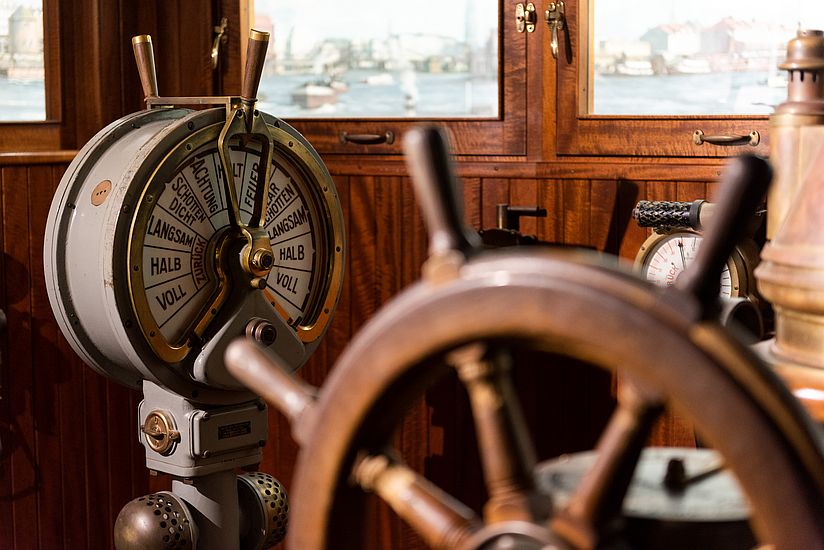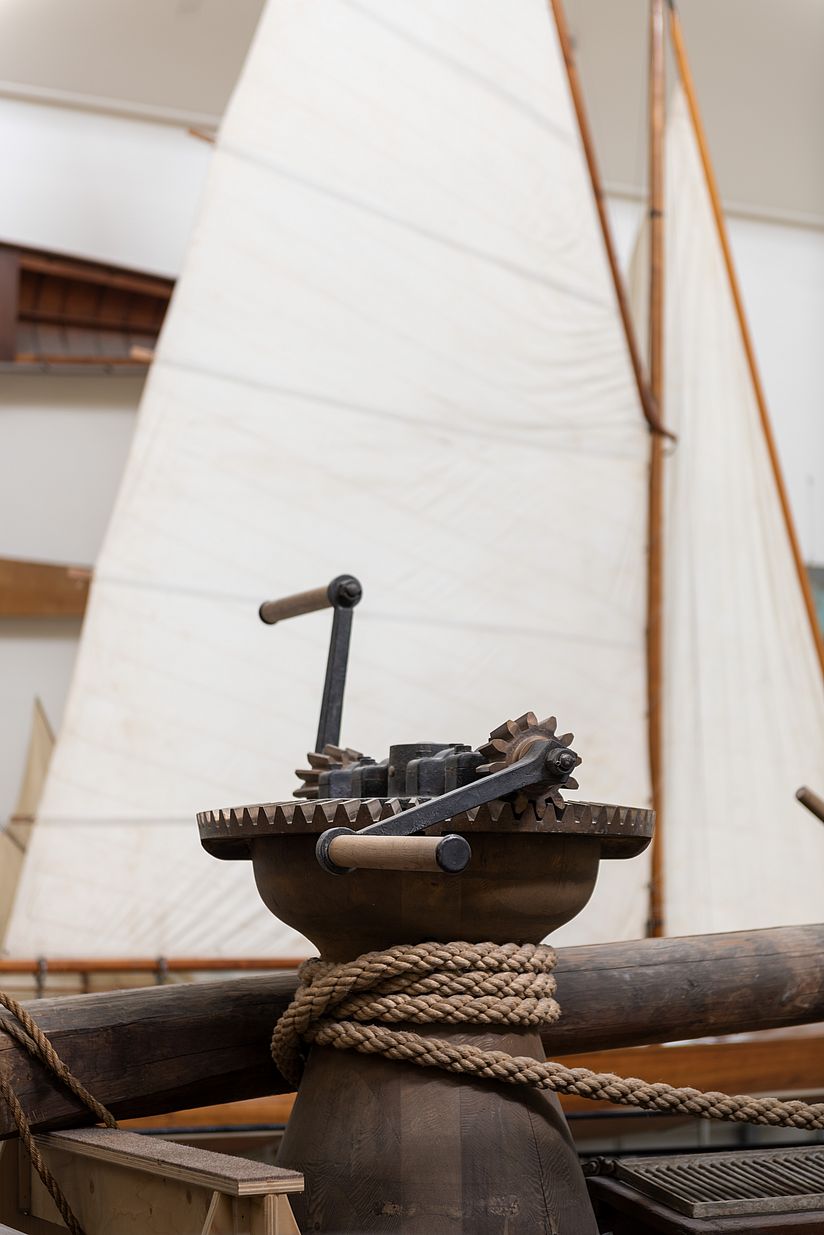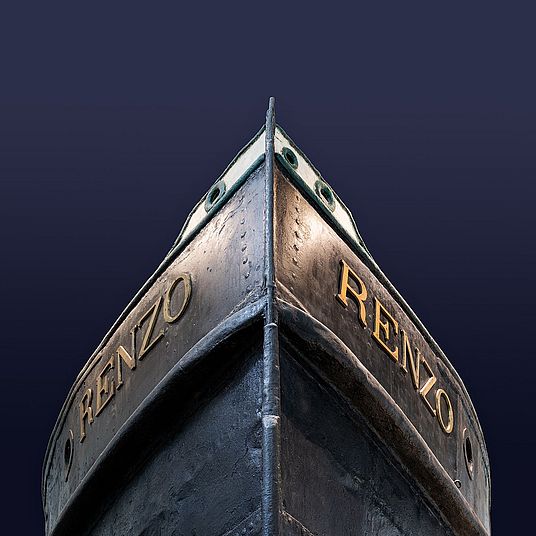
Photo: Deutsches Museum | Christian Illing
Traffic Mobility Transportation
Marine Navigation – exhibition themes
Marine navigation – a bridge between continents. You can find all of the topics and content that are outlined below in the exhibition.
Photo: Deutsches Museum | Christian Illing
With wind, steam and muscle power
Ships are full of stories. The sailing ship “Maria” demonstrates the tough life of fisherman 140 years ago in northern Germany. Ships made of steel and iron, such as the steam tug “Renzo” shaped the industrialisation of marine navigation. The ship “Renzo” pulled barges through the Venetian Lagoon from the 1930s until it ended up in the Deutsches Museum. The heart of the ship, the engine room, is accessible.
In order to move on the water, people initially had to build a suitable vehicle out of the materials that they found in their environment: reeds, grasses, trees and animal hides. Depending on the skills of the people making them, boats in various shapes and sizes appeared throughout the world.
Photo: Deutsches Museum | Christian Illing
Toward new shores
A series of models on Level 0 provides a glimpse into the past. What kind of ships did shipbuilders build in different eras and which prevailed? From the Vikings’ ships and the cogs that maintained the Hanseatic trading network to the caravels and three-masted vessels that paved the way for the exploitation of the Earth’s resources in global voyages, and the fast clippers of the 19th century, many ships are exhibited here at a scale of 1:50.
In addition to the technical features of the ships, this exhibition area also addresses the cultural and economic aspects of marine navigation. The era of European expansion shows well-known or legendary types of ship such as the screw steamer GREAT BRITAIN or a P-Liner, as the sailing ships of the shipping company F. Laeisz based in Hamburg, Germany, were known.
Photo: Deutsches Museum | Christian Illing
Reliable technology and safe navigation
How is a ship built to navigate the sea safely. A diorama shows the steps involved in building a wooden ship, from the laying of the keel to the launch. In addition to the construction, the propulsion systems of ships have also changed over time. Why did Daimler test its petrol engine on a small boat first? Why do modern ships no longer have paddle wheels? The exhibition presents important steps in the development of the technology.
The technical progress in the field of navigation made voyages increasingly safe. The invention of the sextant improved measurements of the angle of stars, which had previously been performed with a cross-staff. The development of precise ship’s chronometers made it possible to determine the longitude. The construction of steel ships made navigation with a magnetic compass increasingly difficult. The ingenious invention of the gyrocompass provided a remedy and made a number of new applications possible.
Photo: Deutsches Museum | Christian Illing
Power and prestige
Its great significance for trade also made the sea an arena for demonstrations of power. In this area, you will find warships from the two world wars. They were built as objects of prestige or for mechanised warfare. Here, you can also travel even further back in time and experience life on the gun deck of a frigate.
Dive down with us: the first major original submarine of the German Imperial Navy can be found in the basement of exhibition. It is cramped in here; is there a toilet alongside the torpedoes? Discover how the Munich-born inventor Wilhelm Bauer advertised the new technology with his submersible, and see where the application led in World War 2 with a disquieting glimpse inside a midget submarine.

Photo: Deutsches Museum | Christian Illing
Yearning and danger: voyages across the sea
Land ahoy! In the basement, you can experience the view from a ship’s promenade deck or a ship’s wheelhouse on the journey into the port of Hamburg, Germany. In the ship's corridors and cabins, you might think that the boat is moving.
But not everyone travelled so well: the glimpse into steerage on an emigrant ship tells of the hope and deprivation of the Europeans who left their homes between 1850 and 1914.
As the transportation of passengers increased, so did tragic maritime disasters. As a consequence, the German Maritime Search and Rescue Service was founded in 1865. A diorama shows how guns were used to establish a connection with the disabled ship and how people were rescued with a breeches boy.
Photo: Deutsches Museum | Christian Illing
Boats
In order to move on the water, people initially had to build a suitable vehicle out of the materials that they found in their environment: reeds, grasses, trees and animal hides. It was possible to create a variety of boats from these: rafts by bundling together buoyant materials or inflated hides, dugout canoes by hollowing out tree trunks or covering frameworks with hides or pelts. In the leisure-oriented society, such forms of boats were revived in order to experience seafaring in a new way in rowing or sailing.
The mere assembly of wooden planks proved to be capable of development and made it possible to produce larger and larger ships through sophisticated joining techniques.

Photo: Deutsches Museum | Christian Illing
Sailing ships
The development of sailing ships is presented in the exhibition – from the Vikings’ ships and the cogs that maintained the Hanseatic trading network, to the caravels and three-masted vessels that paved the way for the exploitation of the Earth’s resources in global voyages, and the fast clippers of the 19th century. Steel tall ships such as the “Preussen” built in 1902, one of the famous “Flying P-Liners” from the Hamburg shipping company F. Laeisz, brought the era of the sailing ship to a close. After World War 1, sailings ships were almost entirely supplanted by steam ships and motor vessels. It was at that time that the romanticised image of the “windjammer” emerged.
Photo: Deutsches Museum
Shipbuilding
Until the 19th century, shipbuilding was still governed by the artisan tradition of wooden shipbuilding. In addition to the typical woodworking tools and prototypes, example models are arranged in a development series. In a diorama, you can follow the craft of the ship’s carpenter through the various stages of construction, from the laying of the keel to the launch; you can also compare this with the diorama next to it of a shipyard for steel ships around 100 years later.
Photo: Deutsches Museum | Christian Illing
Navy
This area features a collection of warships from various eras and the replica of a gun deck. The build-up of the Germany’s Imperial Navy (before World War 1) and the Reichsmarine (before World War 2) followed political and technological strategies; many developments were preceded by private initiatives. Examples of this are Wilhelm Bauer and his demonstration model of a submersible (1852/53) as well as the first attempt at radar processes in the form of the “telemobiloscope” invented by Christian Hülsmeyer (1904). The first German submarine U1, which was commissioned in 1906, entered the museum’s collection as early as 1921/23.
Photo: Deutsches Museum | Christian Illing
Passenger ships
The passenger ships of the turn of the century represented the prestige of the industrialised nations in terms of their performance and their design, for example the “Kaiser Wilhelm II.” (1903) or later the "Europa" (1928), both of which held the coveted Blue Riband speed trophy. A sectional model of the “Kaiser Wilhelm II.”, which was launched in 1902, shows the luxurious interior design of this “floating city”, which also reflected the class society afloat. After World War 2, aeroplanes took over the carriage of passengers across the oceans.

